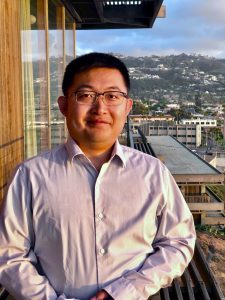A Physical Interpretation for Anomalous Source Spectra with a Deficit at Intermediate Frequencies

Yongfei Wang
Geophysics Joint Doctoral Candidate
UCSD / SDSU
Sponsored by Dr. StevenDay
Wednesday, May 8th at 1pm
CSL 422
Abstract
Many small crustal events in the northern Ibaraki prefecture and the Fukushima prefecture Hamadori area of Japan deviate systematically from the standard omega-square model, with an intermediate-frequency deficit (concavity) in the spectra and low- and high-frequency bumps in residual spectra that may reflect source complexity (Uchide and Imanishi, 2016). This anomaly may result from propagation effects (e.g., multipathing or attenuation) or source complexity (e.g., asperity or barrier models). We investigate the multipathing hypothesis by testing if the anomaly is specific to certain stations or paths, but find that the anomaly is broadly distributed over station location, azimuth, and source depth. With respect to attenuation, we find that a frequency-dependent Q model (e.g., power-law Q) can theoretically explain the spectral concavity if the falloff of inverse Q at high frequency is close to predictions of a Debye peak, but the required falloff rate (-1) is much steeper than permitted from Q studies and observations of source spectra. Thus, source effects are a more likely explanation for the anomalous spectra and we find that a composite source model (an outer big circle filled with smaller subevents) can account for the concavity in spectra. Compared with asperity models with varying stress drop, a model with appreciable acceleration/deacceleration in rupture velocity and variant subevent sizes appears a viable candidate. By simulating dynamic rupture scenarios and performing analytical derivations, we discover such a model has: (1) a high frequency decay with omega-square asymptote that is mainly controlled by outer marginal stopping phases, (2) spectral concavity that is related to the spatial density and the maximum/minimum radius of the subevents, and (3) seismic moment in this composite source is self-similarly proportional to the cube of the outer radius. Thus, based on spectra from our dynamic simulations, we can construct a physical link between stress drop and apparent corner frequency for our composite source model, similar to that described for simpler models in Madariaga (1976), Kaneko and Shearer (2014, 2015), and Wang and Day (2017). In the future, we would like to generalize a spectral model to deal with composite sources to better characterize source complexities and stress regimes.
Bio
Yongfei Wang is a PhD candidate of joint SDSU/UCSD Geophysics program. He, under supervision of Prof. Steven Day and Peter Shearer, has been working on observability of rupture dynamics. He won Best Student Presentation Award of Seismological Society of America twice and Paul Silver research enhancement award. He received his B.S. in Geophysics at University of Science and Technology of China. He will begin his postdoctoral research at Southern California Earthquake Center, University of Southern California.

